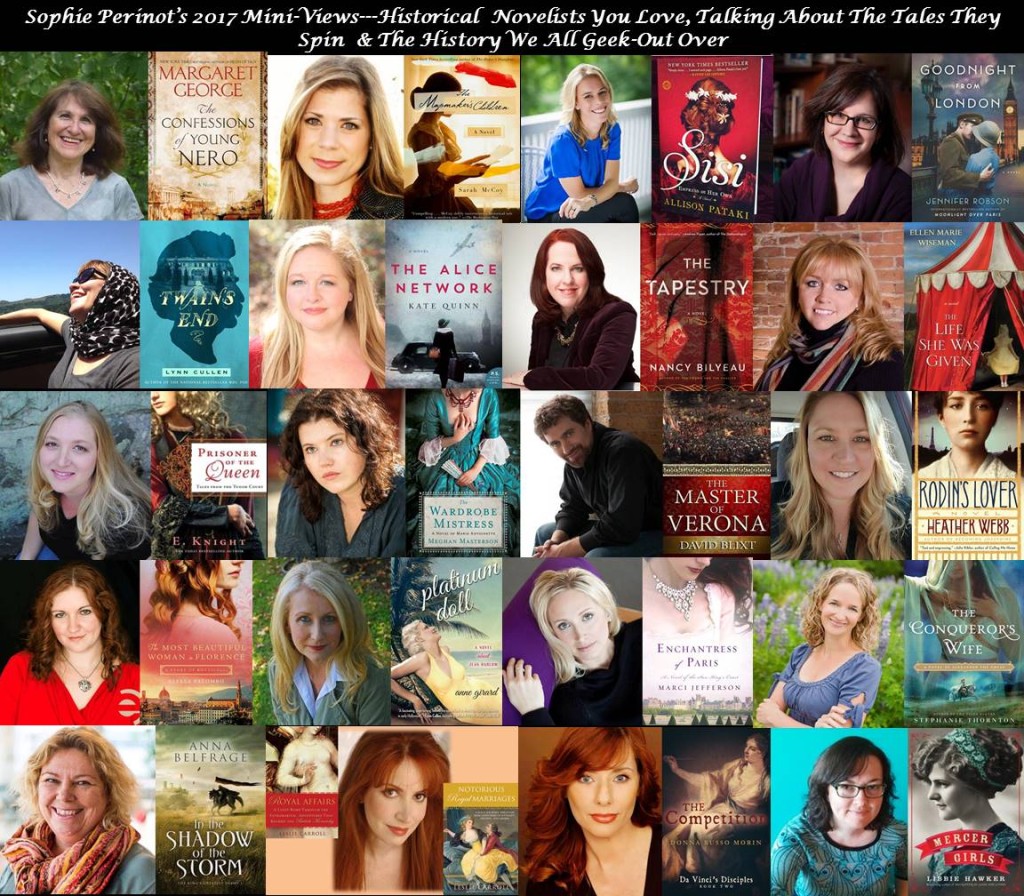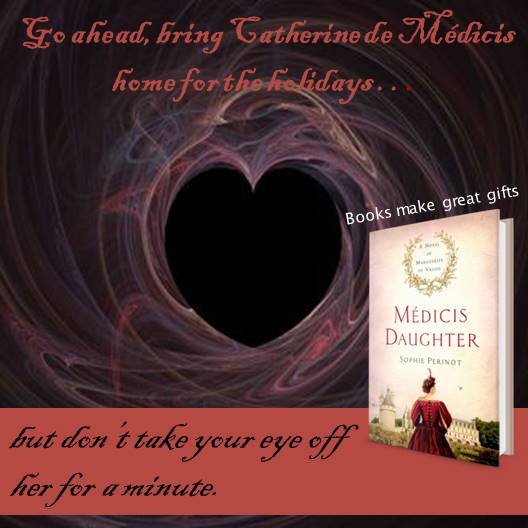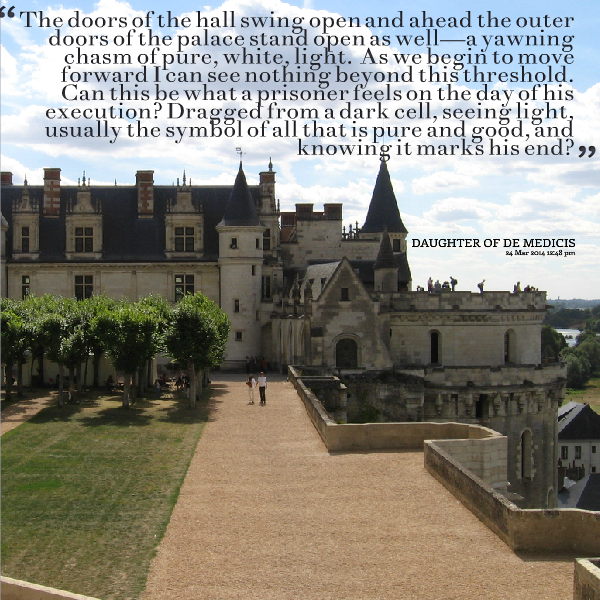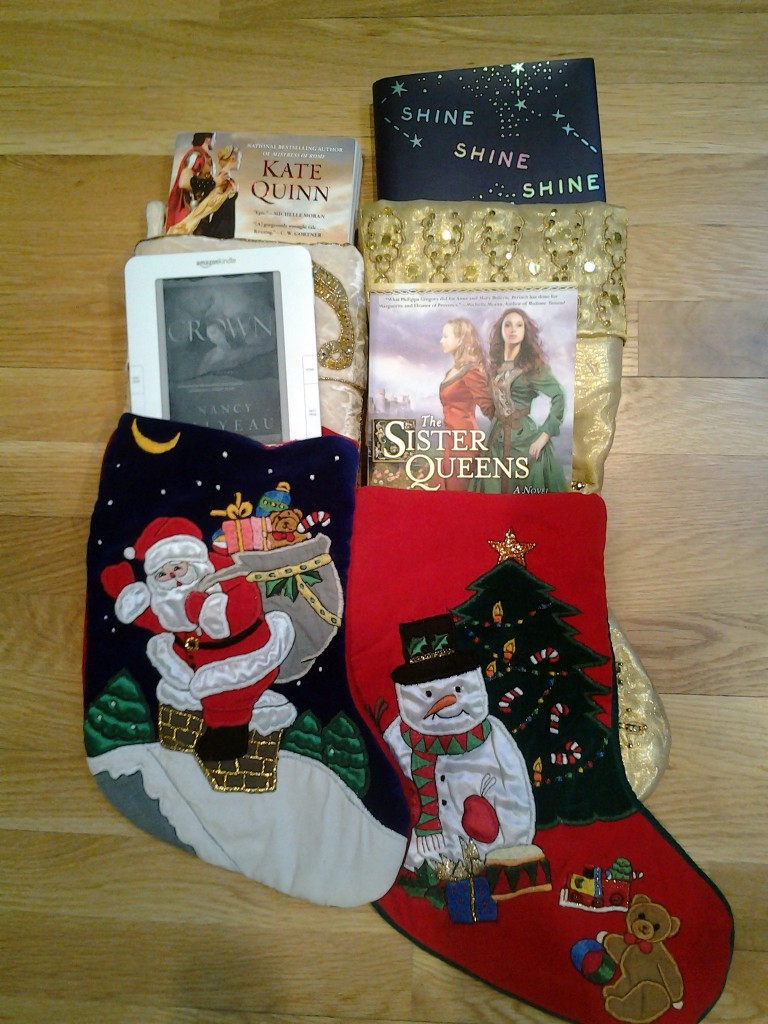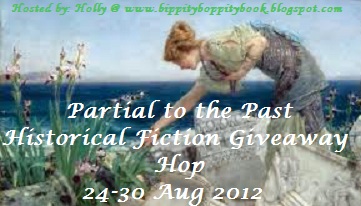Tag: Nancy Bilyeau
An Amazing Time in San Antonio: The Historical Novel Society North American Conference 2023
Hello dear readers! I am just back from the biannual North American HNS conference. Bit of trivia—I’ve attended every American HNS conference since the very first, held in Salt Lake City in 2005. Back then I was still working on my first manuscript and had no agent yet. Over my three days in Utah and I learned so much about the industry! To this day I consider the HNS conferences an indispensable event for staying up to speed on the publishing industry and gaining insights into the craft of writing for those of us writing in the historical genre. They are also a heck of a lot of fun.
I was a panelist in San Antonio, discussing the logistics of pen names—their creation, branding and management—along with the talented Eliza Knight, Libbie Grant and Kris Waldherr. Our panel had a specific focus on using multiple pen names, which means I got to be both Sophie Perinot and Evie Hawtrey in the same place at the same time (a first)!
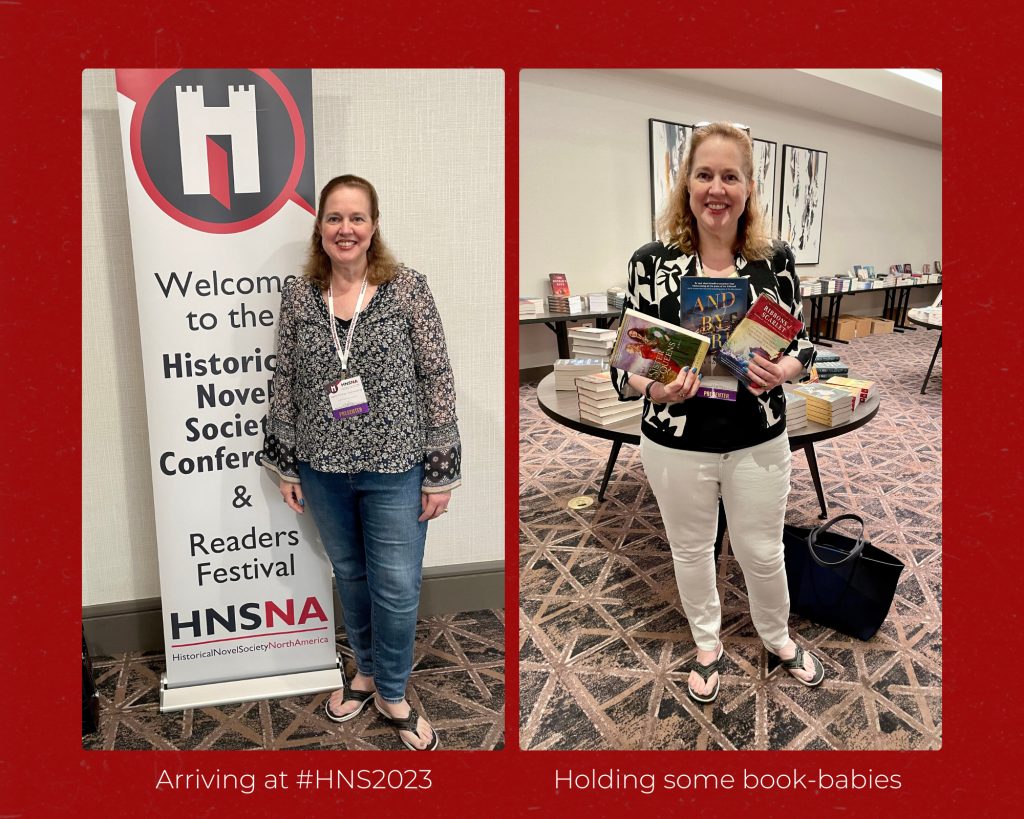
Below you will find some photo highlights of the conference, featuring myself and other historical fiction authors you likely read, as well some of what we got up to. Enjoy! I certainly did!

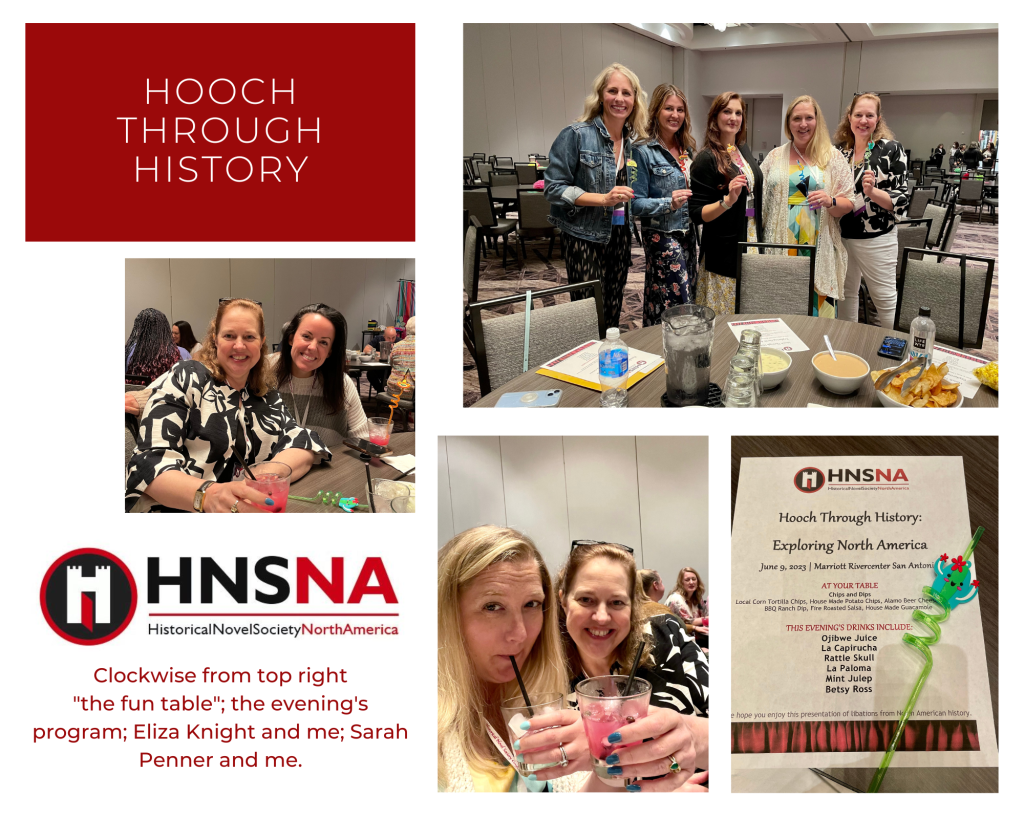

Clockwise from top left: Eliza Knight, Heather Webb and me; cotton candy cocktail; Mariah Fredericks, Karen Odden and Judith Starkston; margaritas; Karen Odden and me; Kate Khavari and me; best guacamole ever. And right smack in the center–Nancy Bilyeau and me.

Exciting Mini-View Lineup For 2017!!!
Wondering if you should bother to open my AUTHOR NEWSLETTER when it pops up in your mailbox? Or whether you should SUBSCRIBE?
Look at this Mini-View lineup! In just in the first three issues of my author 2017 newsletter readers will hear from:
NYT bestsellers: Allison Pataki and Sarah McCoy; USA Today bestseller Jennifer Robson, as well as authors Anna Belfrage; Leslie Carroll; Eliza Knight; Meghan Masterson; Stephanie Thornton; and Ellen Marie Wiseman.
And that’s just for starters. HEAR SOME OF THE TOP TALENT IN HISTORICAL FICTION talk about topics like: dangerous historical women, writing about society’s outsiders, surprising things historical women did, the men who populate history and how they would cast their book as a TV mini-series!
5 BOOKS REIGN FANS SHOULD BE READING RIGHT NOW
Twenty-two days. If you are a fan of Reign you know exactly what I mean.
There may be only eight days until Christmas, but the gift that devoted watchers of the CW’s Reign are really waiting for—the return of the show after winter break—doesn’t arrive until the evening of January 8, 2016. “What can we do,” I hear a communal cry rising, “besides re-watching the existing episodes, to ease our pain during in the countdown?”
How about reading about the Valois and the Queen of Scots? There’s enough intrigue, forbidden love, and danger among that cast of characters to fill not only hours of TV but shelves of books. Ask Santa to deliver a little 16th century Reign-related love when he climbs in his sleigh a week from today by bringing you one or more of these . . .
FIVE BOOKS DESTINED TO DIVERT REIGN FANS while the show is on hiatus (and I want you all to remember, I scooped Buzzfeed Books on this one):
1. Médicis Daughter by Sophie Perinot (hey, it is my blog so I get to lead with my book, but that’s not naughty because the critiques agree the book is oh so nice): This story of Valois family dysfunction, political treachery, forbidden love and bloodiest massacre in French history has been called, “A riveting page-turner skillfully blending illicit liaisons and political chicanery.” (~Kirkus Reviews)
More importantly for Reign fans, Amazon reviews suggest it “would be a great gift for any … fan of the show Reign.”
Médicis Daughter draws readers deep into the world of the Valois in the post-Francis period. With young King Charles IX on the throne and Catherine de Médicis pulling the strings and plotting the plots (some things never change), you KNOW there will be plenty of dark and dirty. Viewed through the eyes of the youngest Valois Princess, Marguerite, the court comes alive: “Atmospherically, the novel swept me off my feet. Perinot’s depiction of the French court was beautifully drawn and I was wholly captivated by both the political and social interaction that unfolded among its players.” (~Flashlight Commentary). When the hearts break and the blood flows you will be right there, unable to look away. “I couldn’t put down. And when I wasn’t reading it, I was thinking about it.” (~The Readers Hollow)
2. The Serpent and the Moon by HRH Princess Michael of Kent: Instead of heading forward, travel backward to the pre-Reign Valois world with this fascinating volume of popular history. This book relates the story of the battle between Catherine de Médicis and Diane de Poitier for the heart of, and influence over King Henri II of France.
There are so many fascinating but at the same time creepy details here for Reign fans to savor. From the moment 14-year-old Catherine arrives in France to discover her husband already in the thrall of a woman who was present at his birth (I told you it was creepy), through the humiliating and disgusting remedies she tried to combat a decade of childlessness, up to Catherine’s vengeful taking of Château Chenonceau from Diane after Henri’s death (and the evidence of the black arts that Diane found when she took possession of the Chateau she was given in exchange) this book will illuminate Catherine to her fans and foes alike.
Need a tempting detail? How about this: Catherine summoned an Italian carpenter to the Place of Saint-Germain where her bedroom was immediately above that of her husband’s mistress. She had two holes made in the floor of her room and then watched Diane and Henri in bed, sobbing later to friends that “her husband had ‘never used her so well.’”
3. The Confessions of Catherine de Medici by C.W. Gortner: In this novel “the most dramatic events of Catherine’s adult life includ[ing] the 1572 Bartholomew’s Day massacre of Protestant Huguenots, [are] vividly and chillingly depicted” (~Historical Novel.info). Publishers Weekly called Gortner’s novel, “”A remarkably thoughtful interpretation of an unapologetically ruthless queen,” and I must say I quite agree. Catherine devotees among the Reign fandom will eat this one up.
4. Blood Between Queens by Barbara Kyle (part of her Thornleigh Saga): Like a thriller element with your history? Have you been enjoying the Mary vs. Elizabeth of England plotline in Reign? Then try this book. My friend Nancy Bilyeau (whose own series about Tudor-era England—beginning with The Crown–I utterly adore) called Kyle’s book, “a fast-paced and exciting historical novel that plunges readers into the deadly rivalry of Elizabeth I and Mary Queen of Scots just as the beautiful three-time-married monarch had fled Scotland for her cousin’s kingdom.” If Nancy says, it “captures the high-stakes politics of the Tudor court, depicting its most famous personages with both accuracy and imagination,” I guarantee you it does.
5. The Wild Queen: The Days and Nights of Mary, Queen of Scots by Carolyn Meyer (from the Young Royals series). I am closing out my list with this YA novel recommended by a big-time Reign fan of my acquaintance (she’s also a history devotee who is always stumping her fellow fans with her “royal pop quizzes”). Currently the Amazon #1 Best Seller in Teen & Young Adult Renaissance Historical fiction, this novel follows the recently widowed Mary home to Scotland where she hopes that a new husband will not only help her to secure her own throne but will allow her to take the crown of England from her cousin, Elizabeth. Too bad, as the back cover reveals, “the love and security she longs for elude her . . . [and she] finds herself embroiled in a murder scandal that could cost her the crown.” Or rather too bad for Mary but NOT for Reign fans because if that doesn’t sound like an episode of the show I don’t know what does!
So there you have it, a bit of Christmas magic for all the Reign fans out there who need something both naughty and nice to get them through until the next new episode. Spread the word . . . spread the Reign-style joy. And Happy Holidays!
My Writing Process
My good friend and “goddess of historical fiction” Kate Quinn tagged me in this cyclical blog tour (make sure you pop over to Kate’s blog and see her answers then follow the chain back for insight into the minds and work habits of other historical fiction luminaries like Christy English and Stephanie Dray). Four questions designed to reveal how we do what we do—write books that is. Answering is harder than you think (as is writing books) because most of us write as we breath—because we are compelled to. And, unless called to account by questions such as these, we don’t think a lot about it.
1) What am I working on?
I am putting the finishing touches on “Daughter of de Médicis: A Novel of Marguerite de Valois” before handing it over to my agent for his input. I consider the book a true bildungsroman, focusing on the psychological and moral growth of the enigmatic Marguerite de Valois from the point at which she comes to live with her brother Charles IX’s royal court as a young girl to the moment when she is transformed by a tremendous historical event (the Saint Barthlomew’s Day massacre in Paris) into an independent adult. I’ve always been fascinated by Marguerite—daughter of a King, sister of three and wife of Henri IV. Had she lived in England Marguerite would have ruled in her turn, but Salic law in France relegated her to the sidelines. Her relationship with her powerful mother, Catherine de Medicis, is an important aspect of the novel. Let’s face it, the mother-daughter relationship is always fraught with peril during the teen years, but imagine if your mother was Catherine de Medicis!
If you are interested in learning more about “Daughter of de Medicis” (including more cool sneak-peek quotes like the one below), it has its own Facebook page.
2) How does my work differ from others of its genre?
Every author’s voice is different. I have mine. You either like it or, perhaps, you do not. But it is different from anyone else’s. Beyond that I cannot opine because I make a conscious effort NOT to compare my work to the work of other historical novelists. In writing as in life I find such behavior is not particularly productive. More than that, it can lead to some pretty negative stuff/feelings. I write for the joy of it. I don’t view it as a competitive sport and I fear indulging in comparisons can too often lead to that.
3) Why do I write what I do?
I write historical fiction because I love to read it. Also because I am a bona fide history geek (have my BA in history) from a family of history geeks (my only sister is actually a Professor of History). When I was a child, I visited historical sites while other kids were at amusement parks. I also grew up watching all those Masterpiece Theater costume dramas of classic literature, and ninety-nine percent of my favorite books were (are) set in the past. So, historical fiction was a natural niche for me. Since I studied French abroad, and I am a devotee of Alexandre Dumas, peré, both my first novel (“The Sister Queens”) and “Daughter of de Medicis” have French history at their centers.
4) How does your writing process work?
“School is my friend.” I bet every parent out there who works at home can identify with that. When my writing is going well, the hours between dropping off and picking up my son from school are devoted 100% to writing. This can have some unfortunate side-effects—usually in the form of the plaintive cries of family members claiming they are, in fact, wearing their last pair of clean underwear. To balance my various roles and not feel like a hamster on a wheel, I try to be fully present and in each given moment. I try not to think “oh my god, you should be writing” when I am not. That kind of thinking tends to just create a guilt-induced writer’s block when I finally sit down at the keyboard. Oh and I don’t compare my daily word count to others—ever. I am a “slow first draft” writer, but the first drafts I eventually produce tend to be close to ready to handover to my critique partners, agent or editor. Finally my process involves weekly summits with a pair of fellow novelist whose work I adore and opinions I respect. We work through problems and set goals—basically we keep each other on-track and honest in a profession that can, by virtue of its solitude, allow for a good deal of procrastination.
Well that’s all she wrote—or rather how she writes (with the “she” being “me). My friend Nancy Bilyeau is up next. On Monday, April 7th she will offer insight into her own creative process, a process that’s led to her gripping Sister Joanna Stafford series (“The Crown” and “The Chalice” with a third installment on the way). Check back here next Monday March 31st, and I’ll link to her site so you can see what her answers are.
Historical Novel Society Conference Teaser—Meet HNS Panelist Nancy Bilyeau
In less than a month I will be off to the 5th North American Historical Novel Society Conference in St. Petersburg Florida, where I will be sitting on two panels—“Location, Location, Location” (discussing how setting is the mortar board upon which historical novels are built and tackling topics related to recreating period locations); and “The Feisty Heroine Sold into Marriage Who Hates Bear Baiting: Clichés in HF and How to Avoid Them” (title of this one says it all). 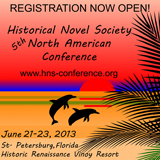
Those of you who were kicking around this then-new blog 2 years ago know what my conference attendance means. . .lots of juicy post-event blogging on trends in the genre and topics of historical fiction interest. But why should you wait until after? How about a conference teaser—an interview reunion with HNS panelist, Nancy Bilyeau.
Nancy is the author of a pair of marvelous historical thrillers following the adventures of novice nun, Joanna Stafford, as she seeks to survive and thrive in Henry VIII’s England while the monasteries are dissolved around her. Nancy’s first book, The Crown, released in 2012 to immediate critical acclaim. “O” (The Oprah Magazine) called it, “A juicy blend of lust, murder, conspiracy, and betrayal.” Nancy’s second book, The Chalice, released this past spring to the eager embrace of existing fans and new ones alike.
Nancy last visited me immediately after the release of her debut novel. I present for your pleasure an update to that interview.
1) Since we last sat down together in our virtual chairs your second novel, The Chalice, came out. Can you tell us a little bit about the new book?
In the second book, it’s 1538, and my main character, Joanna Stafford, is caught in the crosswinds of time. She is a Dominican novice without a nunnery—Henry VIII has broken with Rome, and all the monasteries have been seized. Joanna must decide what path to follow now, and while she seeks a quiet life of tapestry weaving and raising her orphaned relative, Arthur, the kingdom is far from stable. There is a conspiracy against the king, one revolving around prophecy, and Joanna is targeted by those who want Henry VIII off the throne. She learns that the prophecy is about her – and an act she must take in the future, one that could be very dark and dangerous. So the conflict of the book is: If you loved something very much and you had a chance to save it but to do so you must commit an act that is perhaps unforgivable, would you do it? 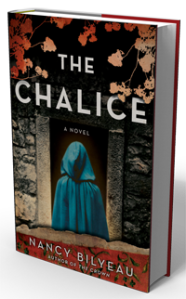
2) inspired you to choose a fictional Dominican nun as the heroine of your series?
I first chose to set a book in the 16th century—simply because it is my favorite century from history. I love mysteries and thrillers, and wanted to attempt to write one with a female protagonist. It took me a long time to figure out who would be the person. I didn’t want a royal or lady in waiting, yet someone living in a Tudor village, I feared it would be too hard to inject that woman into conflict that rises to the level of a thriller. A nun struggling for her future in the middle of the Dissolution of the Monasteries—when the Catholic Church was being violently dismantled—could be quite compelling. Finally, I picked a Dominican because there was only one such order in England, and that made it special.
3) I found it refreshing that Joanna stayed “in character”—true to the religious sentiments one would expect a 16th century nun to have. How difficult was it for you to achieve that? Do you think it was a risky choice given you are writing for a modern—and generally rather skeptical—audience?
One of my pet peeves is characters in historical novels who have modern sensibilities. It’s the easy way out. There is some strange part of my personality that compels me toward the most difficult choices. Sometimes I wish it were otherwise! But as soon as I decided on a nun, I was determined to make her authentic to the spiritual values of the period. I didn’t want to write a book with a reluctant nun who is forced into it by her father or retreats to a priory after rejection by a man. Again, that’s the easy way out. I did worry that readers would be turned off by a spiritual woman but I’ve not seen that reaction. Readers of historical fiction are eager for authentic behavior, I’m more convinced of that than ever. Commit anachronisms at your peril!
The way I tried to achieve it was reading what women in religious orders actually wrote: Catherine of Siena, Hildegarde of Bingen, Teresa of Avila. That helped get me in the proper mood. Also a writing teacher recommended I research the lives of the early female Catholic saints, the ones who were torn to pieces in the Roman Coliseum or who became martyrs in the Dark Ages and medieval period. The thinking of these women is about as far from a 21st century mindset as you can get. Just fascinating. 
4) Besides Joanna, who is your favorite character in the series? Who is your least favorite? Why?
Brother Edmund is my second favorite—I like to think that he is a pretty original character and for some reason I have tremendous sympathy for him. He’s a mix of strengths and weaknesses. I tried my best to make all the characters nuanced. I don’t like two-dimensional people hurtling through thrillers. Or characters with worn-out identifying descriptions: a natural beauty, a strong-jawed man. Ugh.
My least favorite character? Hmmmm. That’s an interesting question. Did I create a character I personally would dislike? Apart from George Boleyn—and I can’t give away why I wouldn’t want to have encountered him at a tender age, or else that would be a spoiler—it would have to be the young prioress in The Crown. She was inspired by a boss I once had—a very difficult one. In fact, I drew on my personal work history, my years in the magazine business, when depicting life in the priory. I thought about it a lot, and decided that though the stereotype of a nunnery was of graceful, serene ladies floating down the halls in harmony, I imagined that there would be the rivalries and tensions found in any group of people essentially working together, and in this case living together too. I was very happy to receive an email from a Dominican nun and two emails from friars that said I captured correctly the essential feeling of life in an enclosed religious community.
5) Truth is often stranger than fiction. In our last talk I asked you about interesting discoveries made while researching The Crown. When you set out to write its sequel, The Chalice, what was the most unusual or unexpected thing you discovered in that process?
I was stunned by how much belief there was in astrology, alchemy and prophecy, from the highest levels of society to the lowest. The mid-16th century was a very mystical time.
6) Writing a series presents special challenges to an author. What, in your opinion, is the most difficult aspect of writing sequential novels? The most rewarding?
The most rewarding aspect is that I love my characters and I want to write them in new situations, whether it’s political crisis or romantic entanglement. I just enjoy spending my time with these people! As for the hardest, well, I am trying to write these books for someone who has never read the ones that come before and also for the fans of the series. It’s hard to serve both kinds of readers.
7) I know you are hard at work on the final book in this series. What will it be called and can you share a bit about it?
I’m excited to share with you that Simon & Schuster has bought the third book. It is called The Covenant. Joanna Stafford finally returns to the court of Henry VIII—and nearly pays for that decision with her life. Someone is trying to kill her and she doesn’t know who. If you’ve read the first two books, you know that there are enough people to form a line. LOL. Also, Joanna will travel outside of England, as she did in The Chalice, but farther this time. And she will make a definitive decision on how she plans to spend the rest of her life, and with whom.
8) In The Crown Joanna brushes elbows with a number of famous historical characters like Catherine Howard and Stephen Gardiner, Bishop of Winchester. In The Chalice you treated us to a face-to-face encounter between Joanna and Thomas Cromwell. Who might we meet in book three?
In The Covenant, many things are going to come to a head that I have been writing about in The Crown and The Chalice. Joanna is a weaver of tapestries and Henry VIII is the most avid collector of tapestries in Europe (that’s true!), and so she will be pulled into the court and the inner circle of the king. Catherine Howard will play a larger role in the third book, which shouldn’t surprise those knowledgeable of history, but readers will see a new side to her and also get to know a much different Thomas Culpepper than has been depicted before. Joanna will stand up to Bishop Gardiner and the duke of Norfolk in this book! And there will be some surprises too. Just as in The Chalice I brought in a character contemporary to this time not usually associated with the Tudors, I have a plan for two other fascinating folks.
9) Like myself, you will be a panelist at the upcoming Historical Novel Society Conference, what is the topic of your panel and what can attendees look forward to learning if they attend?
The name of the panel is “Making It in the Mainstream and What Comes After.” I am honored to be on the same panel as Patricia Bracewell, Deborah Swift, Jenny Barden and Gillian Bagwell. We’re going to talk about what brought us this far and how we plan to keep going.
 About Nancy: Nancy Bilyeau is a writer and magazine editor who has worked on the staffs of InStyle, Rolling Stone, and Ladies’ Home Journal. She is currently the executive editor of DuJour magazine. She was born in Chicago and grew up in Michigan, earning a bachelor’s degree from the University of Michigan. Now she lives in New York City with her husband and two children. Her first novel, The Crown, was nominated for an Ellis Peters Historical Dagger Award 2012 by the Crime Writers’ Association, given to Best Historical Crime Novel.
About Nancy: Nancy Bilyeau is a writer and magazine editor who has worked on the staffs of InStyle, Rolling Stone, and Ladies’ Home Journal. She is currently the executive editor of DuJour magazine. She was born in Chicago and grew up in Michigan, earning a bachelor’s degree from the University of Michigan. Now she lives in New York City with her husband and two children. Her first novel, The Crown, was nominated for an Ellis Peters Historical Dagger Award 2012 by the Crime Writers’ Association, given to Best Historical Crime Novel.
The Sister Queens Makes More “Best Of” Lists
While I was baking up a storm and wrapping gifts for friends and family I received a couple of very special year-end presents. The Sister Queens made several “best of” lists” (in addition to the list at Let Them Read Books mentioned in a previous post).
I am exceedingly flattered that The True Book Addict, has my debut keeping company with books by the likes of C.W. Gortner, Hilary Mantel and my good friend Nancy Bilyeau. Holly’s list at Bippity Boppity Book lets me rub elbows with Ken Follett and Diana Gabaldon (wow). Book Drunkard’s “Top 12” and Tanzinite’s Castle Full of Books both also have me in very august company. I am thrilled that Kate Quinn, author of a brilliant trilogy set in ancient Rome that I personally devoured, also picked The Sister Queens as one of her 2012 favorites and Space Station Mir named me as one of her “Top Ten New-To-Me Authors for 2012.” Finally, I feel very privileged that The Sister Queens made two of the “personal favorites” 2012 lists at Romantic Historical Lovers—Meagan’s and Jenny’s.
Not so sound like The Count from Sesame Street, but by my reckoning that makes nine favorites lists I am gobsmacked and grateful. Thank you to the book bloggers who did me such honor and thank you to all the readers who embraced my first novel so warmly!
Just a thought . . . books make GREAT stocking stuffers!
Interview with Nancy Bilyeau, Author of The Crown
It is my very great pleasure today to welcome friend and fellow historical fiction writer Nancy Bilyeau to the blog. Nancy’s riveting historical thriller The Crown released in paperback earlier this month. Critically acclaimed since its hardcover debut in January, “O” (The Oprah Magazine) called The Crown, “A juicy blend of lust, murder, conspiracy, and betrayal.” I’ve read it. O is right.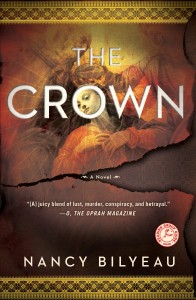
First a blurb to tantalize you: London, May 1537. When Joanna Stafford, a novice nun, learns her cousin is about to be burned at the stake for rebelling against Henry VIII, she makes a decision that will change not only her life but quite possibly, the fate of a nation. Joanna breaks the sacred rule of enclosure and runs away from Dartford Priory to bear witness to her cousin’s execution.
Arrested along with her father at the site of the burning and sent to the Tower of London, Joanna finds herself a pawn in a deadly power struggle. Those closest to the throne are locked in a fierce fight w those desperate to save England’s monasteries from destruction. Charged with a mission to find a hidden relic believed to possess a deadly mystical power, Joanna and a troubled young friar, Brother Edmund, seek answers and clues across England.
And now some questions to take you behind cover-copy (and it’s no exaggeration to say Nancy reveals some things here she has never told readers before):
1) What inspired you to choose a fictional Dominican nun as the heroine of The Crown?
I first chose to set a book in the 16th century—simply because it is my favorite century from history. I love mysteries and thrillers, and wanted to attempt to write one with a female protagonist. It took me a long time to figure out who would be the person. I didn’t want a royal or lady in waiting, yet someone living in a Tudor village, I feared it would be too hard to inject that woman into conflict that rises to the level of a thriller. A nun struggling for her future in the middle of the Dissolution of the Monasteries—when the Catholic Church was being violently dismantled—could be quite compelling. Finally, I picked a Dominican because there was only one such order in England, and that made it special.
2) I found it refreshing that Joanna stayed “in character”—true to the religious sentiments one would expect a 16th century nun to have. How difficult was it for you to achieve that? Do you think it was a risky choice given you are writing for a modern—and generally rather skeptical—audience?
One of my pet peeves is characters in historical novels who have modern sensibilities. It’s the easy way out. There is some strange part of my personality that compels me toward the most difficult choices. Sometimes I wish it were otherwise! But as soon as I decided on a nun, I was determined to make her authentic to the spiritual values of the period. I didn’t want to write a book with a reluctant nun who is forced into it by her father or retreats to a priory after rejection by a man. Again, that’s the easy way out. I did worry that readers would be turned off by a spiritual woman but I’ve not seen that reaction. Readers of historical fiction are eager for authentic behavior, I’m more convinced of that than ever. Commit anachronisms at your peril!
The way I tried to achieve it was reading what women in religious orders actually wrote: Catherine of Siena, Hildegarde of Bingen, Teresa of Avila. That helped get me in the proper mood. Also a writing teacher recommended I research the lives of the early female Catholic saints, the ones who were torn to pieces in the Roman Coliseum or who became martyrs in the Dark Ages and medieval period. The thinking of these women is about as far from a 21st century mindset as you can get. Just fascinating.
3) Your book doesn’t shy away from the unsavory sights or the more malodorous smells of life in Tudor England. In fact, in Joanna’s opening trip to Smithfield the revolting plays a large role. Of course accurate historical details help bring readers to a specific place and time, but I was struck by your very evident emphasis on the unsavory at the beginning of the book. Why specifically did you choose to highlight the grimy side of the 16th century?
I’ve written screenplays and that is a key part of what I like to do: Write visually. It’s not just dialogue and direct character action. I try to do all the research so I can put you on the street, inside the priory cloister, in a barge on the Thames. I wanted to time-travel the reader from the very beginning: You are on your way to Smithfield on execution day in May of 1537, you’re scared and you’re hungry and you’re exhausted—but still resolute. This is what it would feel like, smell like, sound like. Even taste like.
4) Besides Joanna, who is your favorite character in The Crown? Who is your least favorite? Why?
Brother Edmund is my second favorite—I like to think that he is a pretty original character and for some reason I have tremendous sympathy for him. He’s a mix of strengths and weaknesses. I tried my best to make all the characters nuanced. I don’t like two-dimensional people hurtling through thrillers. Or characters with worn-out identifying descriptions: a natural beauty, a strong-jawed man. Ugh.
My least favorite character? Hmmmm. That’s an interesting question. Did I create a character I personally would dislike? Apart from George Boleyn—and I can’t give away why I wouldn’t want to have encountered him at a tender age, or else that would be a spoiler—it would have to be the young prioress. She was inspired by a boss I once had—a very difficult one. In fact, I drew on my personal work history, my years in the magazine business, when depicting life in the priory. I thought about it a lot, and decided that though the stereotype of a nunnery was of graceful, serene ladies floating down the halls in harmony, I imagined that there would be the rivalries and tensions found in any group of people essentially working together, and in this case living together too. I was very happy to receive an email from a Dominican nun and two emails from friars that said I captured correctly the essential feeling of life in an enclosed religious community. 
5) Where have you traveled for inspiration and research for The Crown?
I’ve traveled to most of the places that Sister Joanna Stafford travels to: Dartford, Smithfield, and the Tower of London. Even though the present Tower is closest to what it was in the 1530s, I felt most connected to Joanna in Dartford, in Kent. I walked along the remains of the stone wall that once surrounded the priory of sisters. That is all that remains.
But since I live in New York City, my research trips to England can’t happen as often as I’d like. For inspiration closer to home, I go to the Cloisters Gardens and Museum of the Metropolitan Museum of Art. For anyone who hasn’t had a chance to visit, go! The Cloisters was assembled in the 1930s from a series of medieval French abbeys that they brought over, brick by brick. The re-created rooms are filled with paintings, sculpture, and exquisite objects contemporary to that time. In fact, I got the idea for a murder weapon in The Crown while walking through the Cloisters! I’ve never told any other interviewer that.
6) Truth is often stranger than fiction. During your research for The Crown what was the most unusual or unexpected thing you discovered?
There were certain things I discovered about King Athelstan, the dark ages Saxon monarch, that really surprised me. As much as the Tudor monarchs are over-exposed in some people’s eyes, Athelstan is under-exposed. He arguably was the first king of Britain after he won a enormous battle against the Vikings and the Scots—and no one even knows where the battle was fought. There’s also the question of his sexuality. So interesting.
7) Authors of historical novels walk a line between known historical facts and fiction. Where do you draw the line on your personal map between accuracy and imagination?
My book is not the kind of historical fiction that tells the story, with imagination and new insights, of famous people who once lived. Some “real” people populate The Crown, but most of the characters are from my imagination. And my thriller plot is rather audacious—that’s what folks tell me. So I mixed the carefully researched truth with the fantastical on many pages.
8. Is there anything you’d like to tell us about the Tudor period which even avid readers of Tudor-era fiction might not know—perhaps a preconception you’d like to overturn?
I had no religious or political agenda whatsoever when I started researching this book. But the deeper I got into it, the more I became convinced that the stereotype of a decaying Catholic church that had lost its relevance was wrong. History certainly was written by the winners when it came to the English Reformation. Dartford Priory, where I set most of the book, was a vital center of intellectual achievement and pious observance. Also there was an infirmary in the town run by the priory as well as an almshouse for the poor, and local girls were taught to read there. All that was eliminated when the priory “surrendered” to the will of Henry VIII and the sisters were turned out.
9) Which is most likely to spark the idea for a Nancy Bilyeau novel—a time period, a specific event or a character?
Time period. I am drawn to the time and place, and after that the characters come. Hmmmm. Is that unusual?
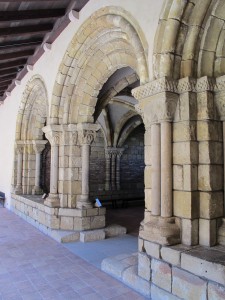
I’d give anything for a lair. I wrote The Crown at the New York Public Library, my kitchen table and various Starbucks. But when I had to write a key scene and needed to get into the mood, I would pack up the laptop and head for The Cloisters. The perfect environment. However, the battery on my laptop would run out in two hours and there are no plugs for writers. Still, I’d take it to the chapter house and sit on the stone “bench” and tap away furiously till the power drained – or the guards started coming after me.
11) If you could read any book again for the first time, what would it be and why?
Rebecca. I read it first when I was in high school and it made a deep and lasting impression on me. I’d like to feel the thrill of some of those revelations again. Since then I’ve re-read it at least six times and come away with a boundless respect for Daphne du Maurier’s craft and also I am so curious about some things in the book. For instance, when Max de Winter tells his second wife that on their honeymoon, Rebecca, laughing, her black hair blowing in the wind, told him things about herself “that I would never repeat to a living soul,” I would love to know—What are those things?
12) I know you are hard at work on the next book in this series, The Chalice, can you share a bit about the new book?
It’s my sequel to The Crown. It’s darker in some ways, with even higher stakes. More executions. And more romance too.
13) In The Crown a Joanna brushes elbows with a number of famous historical characters like Catherine Howard and Stephen Gardiner, Bishop of Winchester, can we expect more cameos from the rich and famous in your sequel? Who might we meet?
Oh I had such a fantastic time researching the “real” people of the time. Gardiner returns, of course; this time Joanna encounters not one but two women who marry Henry VIII. There are a number of aristocrats of the time who played very important parts in history but are not often written about—I put them to work in The Chalice. And finally, Joanna comes face to face with none other than Thomas Cromwell.
About Nancy: Nancy Bilyeau is a writer and magazine editor who has worked on the staffs of InStyle, Rolling Stone, and Ladies’ Home Journal. She is currently the executive editor of DuJour magazine. She was born in Chicago and grew up in Michigan, earning a bachelor’s degree from the University of Michigan. Now she lives in New York City with her husband and two children. The Crown was nominated for an Ellis Peters Historical Dagger Award 2012 by the Crime Writers’ Association, given to Best Historical Crime Novel. Nancy has finished writing a sequel to The Crown, which is called The Chalice.
Watch This Space
No, seriously. Watch it.
This Friday I will inaugurate a series of interviews called “Get to Know the Writers I Know” with a guest appearance by Nancy Bilyeau, author of The Crown. Then ten days later I’ll be speaking (well, you know what I mean) with Erika Robuck, author of Hemmingway’s Girl. As you may suspect from what I’ve posted in this space (or as you know for certain if you’ve ever met me) I am not shy, so you can expect some probing questions and interesting answers.
Happy to Be Part of the Historical Fiction Hop!
Fall is in the air. Cool weather is around the corner and you know what that means—curling up in comfy chair with a good book. If you’re like me “good book” is basically a synonym for “historical novel.” So, in honor of the many lovely hours of autumn reading to come I am participating in the “Partial to the Past Historical Fiction Giveaway Hop,” hosted by Holly of Bippity Boppity Book.
The Hop, dear reader, is your chance to enter not one but TWENTY separate book giveaways. It’s a historical fiction lover’s dream. All the wonderful bloggers and authors participating in the hop have goodies to share. For example, Holly at Bippity Boppity Book is giving away a 3 book prize pack including Outlaw by Angus Donald, The Eagle and the Raven by Pauline Gedge and the just-released The Second Empress by Michelle Moran. While Judith Starkston is giving away four copies of her novel, Rubies of the Viper.
I am offering a fantastic threesome of books all by “Book Pregnant” authors and all signed — my own historical debut, The Sister Queens (click on the title for an enticing description of the book), Nancy Bilyeau’s historical thriller The Crown, and Anne Clinard Barnhill’s At the Mercy of the Queen. To enter use the rafflecopter below then hop on over to other hop-stops (listed below the entry form) and enter to win MORE fantastic books. Who knows, you could end up with a phenomenal autumn TBR pile for free 🙂
